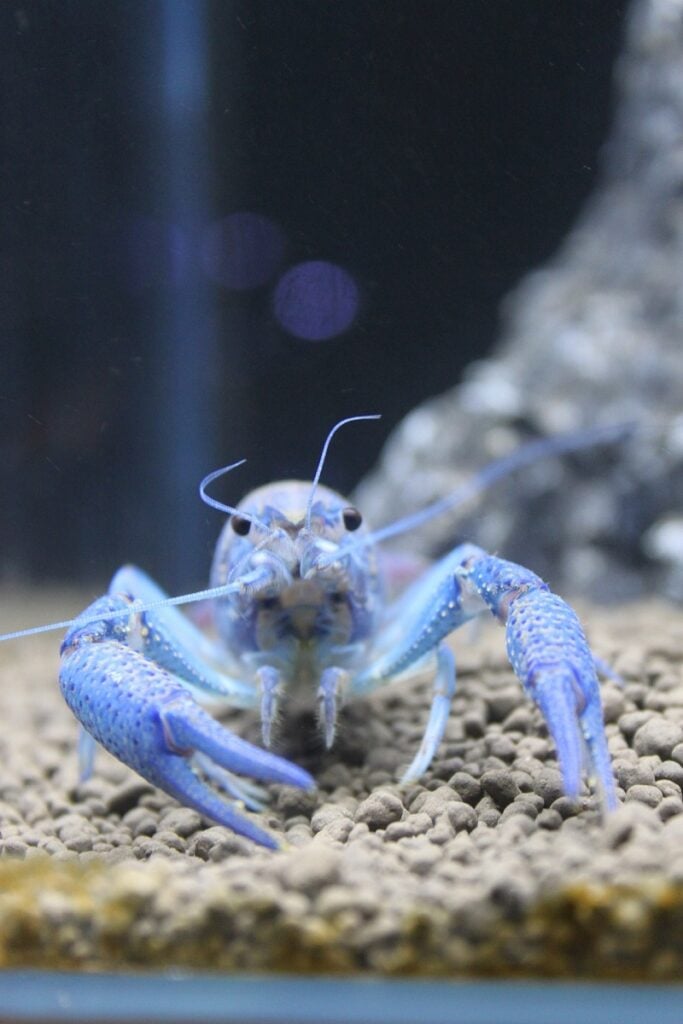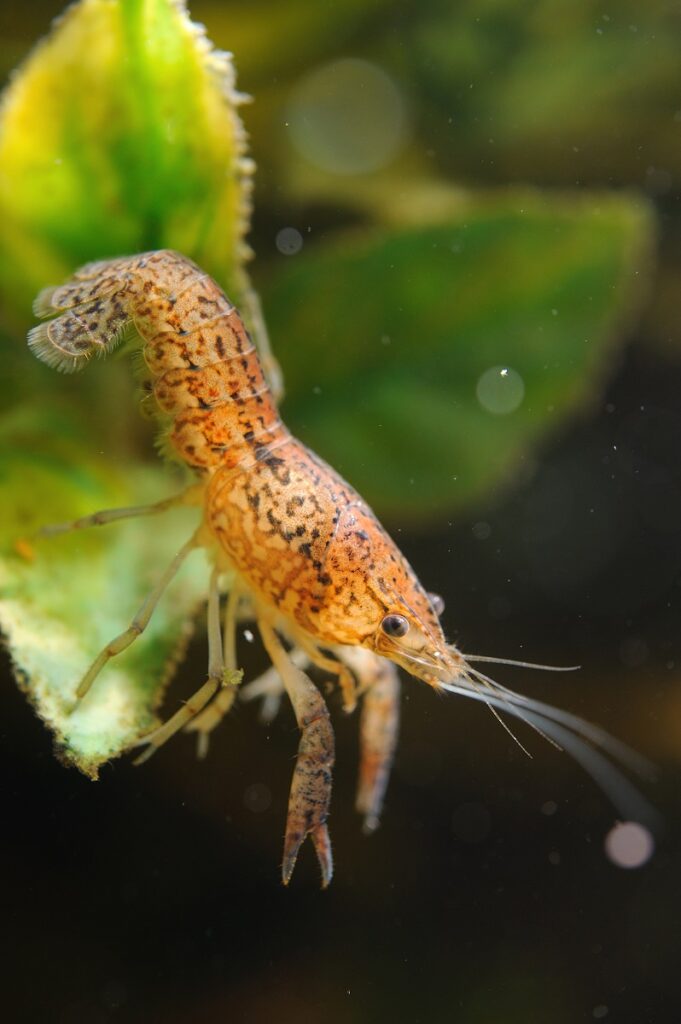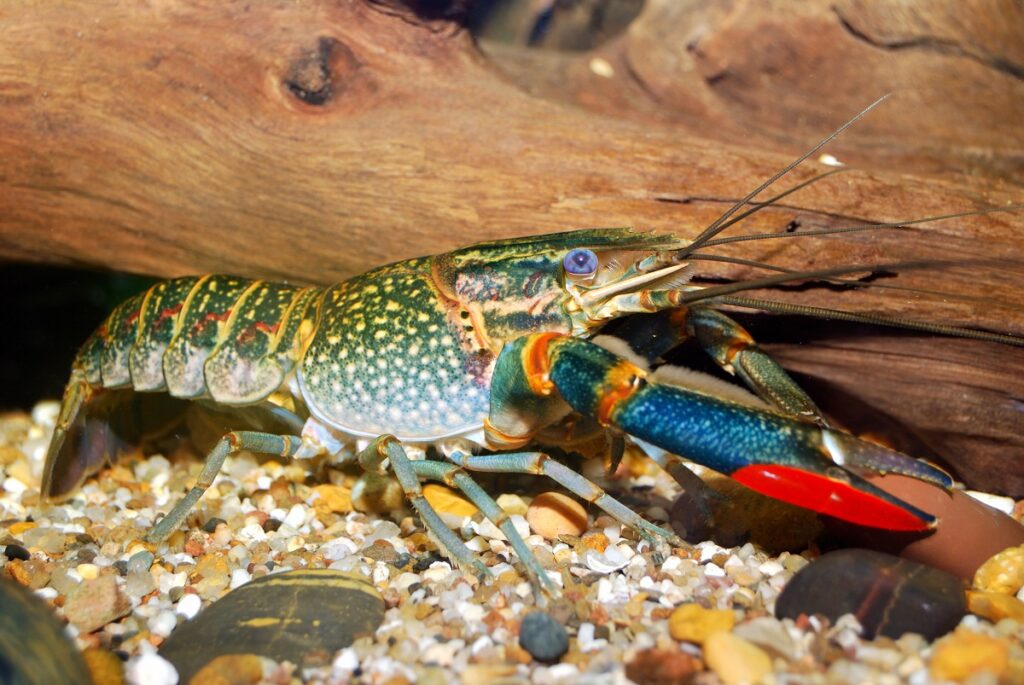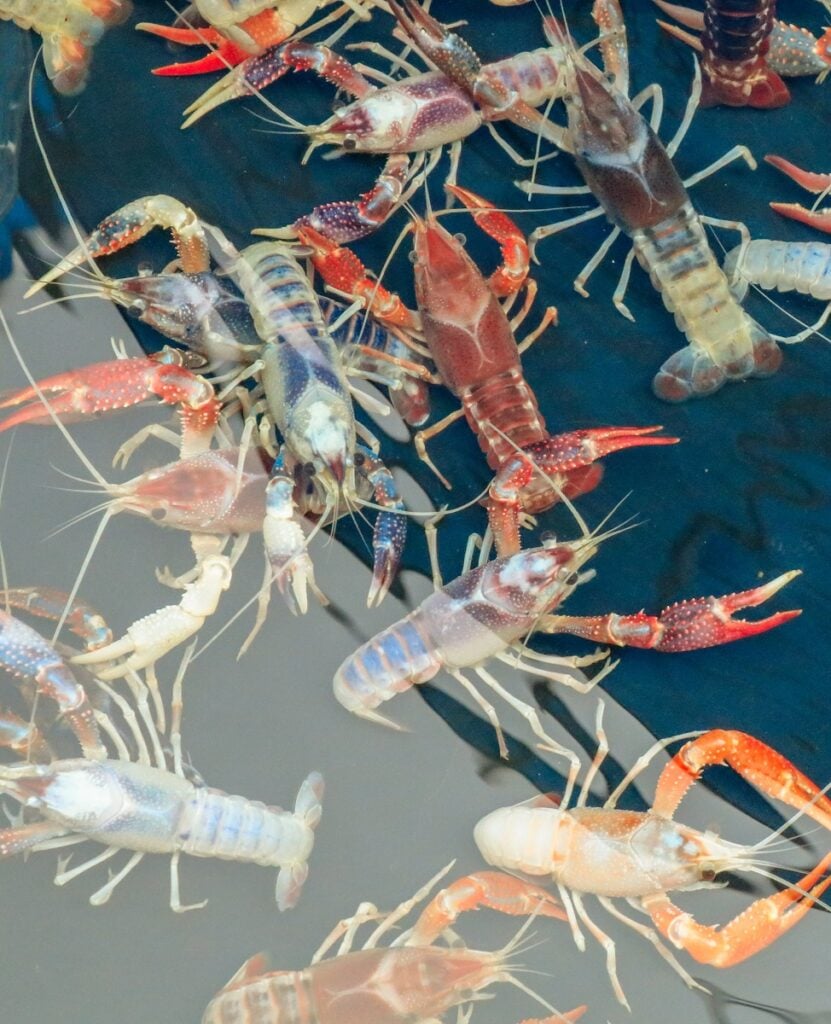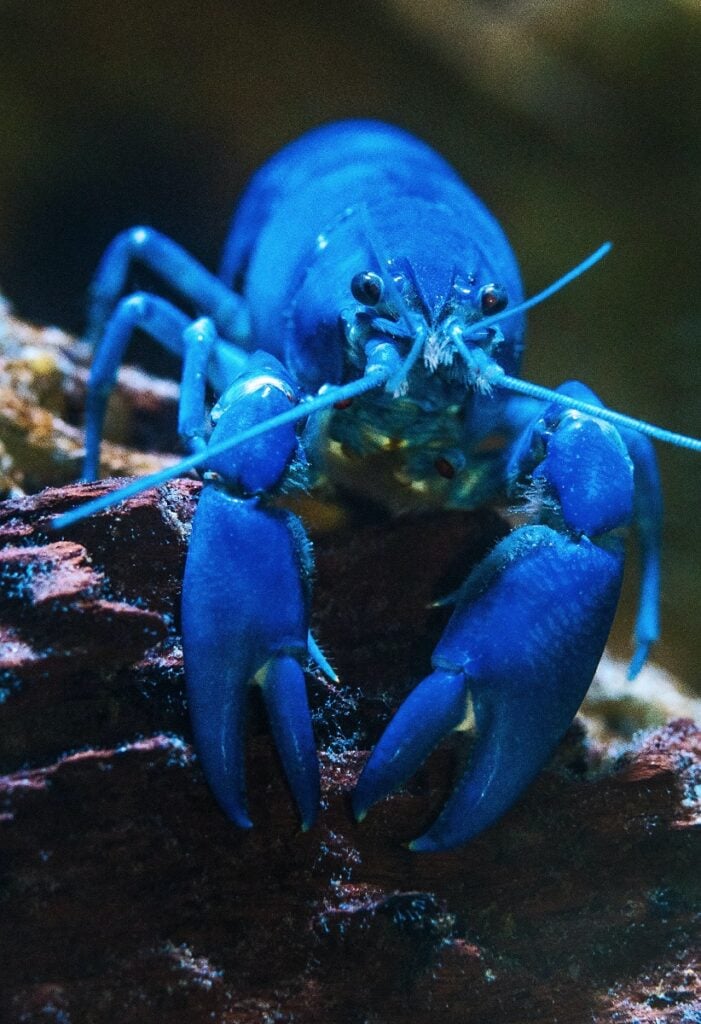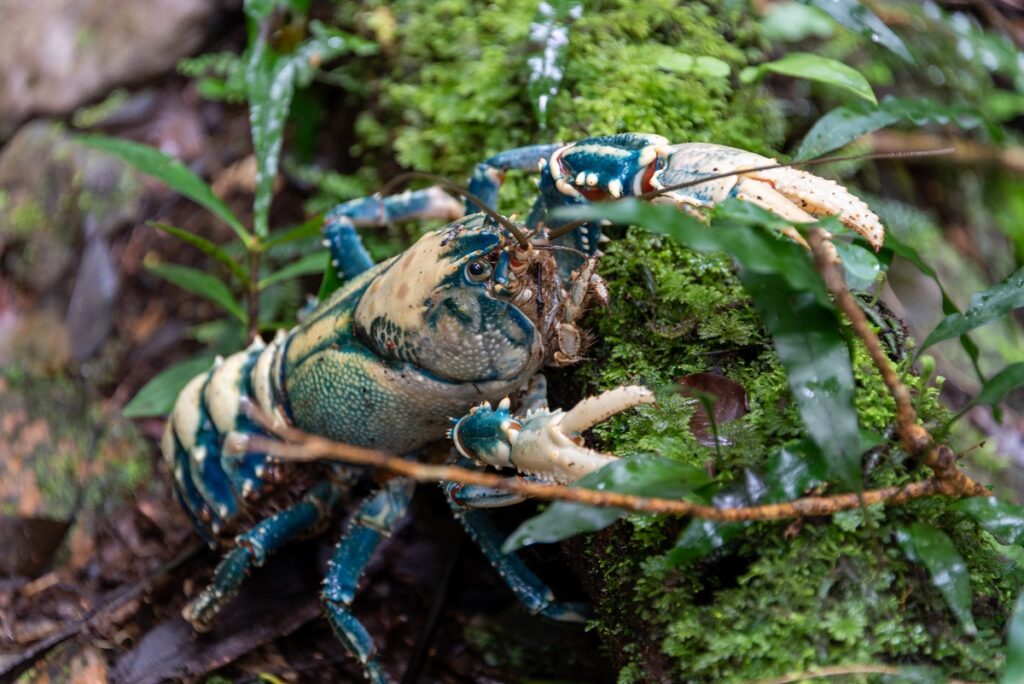5 Aquarium Crayfish For Your Fish Tank
Thinking of setting up a crayfish aquarium? Good choice! These feisty invertebrates are usually seen as food, but they're actually fun to keep as pets. Aquarium crayfish show a bit more personality than many fish and shrimp species, and you'll be able to see all sorts of interesting behaviors: territorial displays, molting and sometimes even baby crayfish being born.
To help you get things going, let's have a look at 5 of our personal favorite aquarium crayfish species.
Table of Contents
Electric blue crayfish (Procambarus alleni)
One of the most common crayfish for the aquarium is Procambarus alleni, also known as the Everglades or Florida crayfish. This species' natural habitat includes much of eastern Florida including the Keys, where it's found in typical crayfish habitat. During wet season, it inhabits ditches, lakes and part of the Everglades. During dry season, if it can't find enough water, it burrows until things flood again.
In the wild, Procambarus alleni is brownish to reddish in color. However, there is a selectively bred blue variation that's become much more popular in the aquarium hobby: the electric blue crayfish. It truly is very blue, to the point where it looks almost unnatural!
The electric blue crayfish can reach a maximum size of around 5", so it's not a small species. As such, you should keep yours in an aquarium of no less than 20 gallons. That's for a single cray, as they're much too aggressive to be able to keep multiple together unless you have some experience with keeping crayfish.
Tip: Larger crayfish species like the ones discussed on this list can be kept with some select tankmates. Quick schooling fish like Danios are a popular choice. However, remember that most will catch and kill whatever they can! Have a look at the list of dwarf crayfish if you're looking for something a little less aggressive.
Marbled crayfish or marmorkrebs (Procambarus virginalis)
Here's a very special crayfish, and also one that has proven rather problematic. Although it's usually known as marmorkrebs, which is simply German for "marbled crayfish", it has another name: the self-cloning crayfish. That's because the females don't need a male to reproduce, as crazily enough, they're able to clone themselves.
I'm sure you can see how the prospect of a self-cloning crayfish is both really cool and also potentially an issue. Even if you keep a single marmorkrebs, since they're always female, your tank could still become overrun with babies! Even worse is when they manage to escape or are released in the wild, as has happened in dozens of countries throughout Europe and beyond. The resulting massive populations can wreak havoc on local ecosystems.
If you live in a place where the marmorkrebs is still allowed to be kept, you can do so in an aquarium of at least 20 gallons. Like most crays, these guys don't care much about water quality, but they do appreciate having access to plenty of caves and other décor to hide in and under.
If you'd like to read more, you can find everything you need to know about this species in the full marmorkrebs care guide.
Tip: All crayfish are known for being escape artists. You better keep a tight-fitting lid on that tank, or you may wake up one day to find your cray attempting to vacate the premises! They can survive on land, but it's obviously convenient to keep aquarium creatures where they belong: in the aquarium.
Australian redclaw crayfish (Cherax quadricarinatus)
Why hello! The aforementioned electric blue crayfish was cool to see, but this rainbow-colored number might just take the cake when it comes to spectacular aquarium crayfish. Its name is Cherax quadricarinatus, the redclaw crayfish, and it's from northern Australia (plus Papua New Guinea). Like the aforementioned marmorkrebs, though, it's also an invasive species in many areas.
In its natural habitat, the redclaw crayfish inhabits streams, ponds and lakes. It's by far the biggest crayfish on this list, reaching a whopping 13" in some cases. The males can weigh over a pound! It's not surprising, then, that an aquarium of at least 30-40 gallons is recommended if you'd like to keep one.
As with other crayfish, caring for a redclaw is pretty easy. Yours will appreciate plenty of hides, especially during molting time. Just don't think you can turn the aquarium into a nice aquascape: crayfish like to "redecorate" their surroundings. They will eat any plants you introduce into the tank, so don't do so unless they're meant as food in the first place.
Red swamp crayfish (Procambarus clarkii)
As this list is making quite clear, there are many beautiful crayfish species out there. Although they're naturally almost all a brown or tan in color, they lend themselves very well to selective breeding for all sorts of colors and patterns! One of the best examples of a spectacularly colored crayfish is Procambarus clarkii, the red swamp crayfish from northern Mexico and northeastern USA.
The red swamp crayfish (or crawfish, crawdad, mudbug) is naturally reddish and widely bred for food. Crawfish boil, anyone?! This being said, the species can also be found in amazing colors and patterns in the aquarium hobby. One of its most well-known incarnations is the white specter crayfish, which as the name suggests, is all white. There's also the spectacular multicolored ghost crayfish, which is pictured below, and the bright orange "Scarlet".
You can keep a red swamp crayfish in an aquarium of at least 20 gallons. They're not fussy about water quality, making them an excellent option for beginning aquarists! The species prefers a plant-based diet mixed with some meaty foods. You can offer a shrimp food as a staple and supplement it with (thawed) frozen foods like bloodworms, for example.
Common yabby (Cherax destructor)
What the aforementioned red swamp crayfish is to the southern US, the common yabby is to much of Australia! Scientifically known as Cherax destructor, this species can reach up to 8" in size and apparently tastes pretty good, which is why it's common to see folks out and about in summer trying to catch them.
In the wild, common yabbies are blue and brown in color. But as always with these crayfish, aquarium breeders have done plenty of selective breeding, which has resulted in a bright blue variety that can rival the electric blue crayfish.
You can keep a yabby in an aquarium of 30 gallons or up. As always, don't bother making it pretty; their name is "destructor" for a reason. Do be sure to give yours an extra thick layer of soft substrate to work with, as these guys absolutely love to dig and burrow. If you don't see yours for a while, don't worry. It's probably happily buried in the substrate, living its best life!
Other aquarium crayfish
Of course, this is by no means an exhaustive list of aquarium crayfish species. If anything, it's pretty incomplete, as it only features the more popular crays! If you have an affinity for these clawed invertebrates, you should expecially check out more of the genus Cherax. Some of their colors are just out of this world.
You might like one of the following:
- Cherax albidus
- Cherax peknyi
- Cherax alyciae
- Cherax misolicus
- Cherax snowden
Did you know? A good few of the Cherax species were first "discovered" in aquariums! Basically, no scientists had described them yet, although they were already being exported and kept as pets. They were only formally described after experts stumbled upon them in the aquarium trade and realized no one knew what they were. This also happened with the marmorkrebs.
Frequently asked questions
Well... everything. They're omnivores that can be fed a varied diet of frozen fish foods, blanched vegetables, pellets, flakes, and much more.
In most cases, it's best to keep a solo crayfish. They can get rather territorial, so if you'd like to keep multiple, make sure there's plenty of space and multiple hides for each individual.
None of the species discussed here can. If you want to keep a crayfish in a nano aquarium, head over to our list of dwarf crayfish instead!
Buying aquarium crayfish
Most aquarium stores will carry at least one or two types of aquarium crayfish, although they may be dwarf species like the popular CPO. Which are available can depend on local regulations, because as we touched upon here, some crays are highly invasive in certain areas.
Their ability to invade local ecosystems can cause local authorities to ban the sale of select crayfish entirely. If you'd like to order online, which is possible at a range of aquarium web stores, be sure to check whether you're allowed to keep the species in question in your state.
Did you know? One of the most spectacular crayfish species is the Lamington spiny crayfish, Euastacus sulcatus. Unfortunately it's protected, so captive breeding populations are rare. But it looks like you can still own one - if you've got $600 AUD to spare, that is!
Faulkes, Z. (2015). The global trade in crayfish as pets. Crustacean Research, 44, 75-92.



 Shrimp
Shrimp Fish
Fish Crab &
Crab & Plants
Plants Foods
Foods Snails
Snails